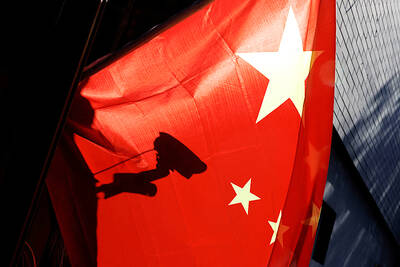A US Department of Defense report on the Chinese military released on Monday briefly criticized Taiwan’s defense spending and its transition to voluntary military service.
The report, Military and Security Developments Involving the People’s Republic of China 2013, said that as the Taiwanese government shifts to a national volunteer force, the freed-up savings and resources are being used for personnel salaries and benefits, but it is “diverting funds from foreign and indigenous [weapons] acquisition programs.”
It said the program did not meet is objective, with a total of 235,000 people inducted into military service in recent years, far below the target of 270,000.
“Taiwan’s military spending has dropped to approximately 2 percent of GDP — well below President Ma’s [Ying-jeou (馬英九)] pledge of 3 percent,” the report said, adding that China’s defense budget is 10 times that of Taiwan.
The annual report to the US Congress covers China’s security and military strategies, as well as the security situation in the Taiwan Strait.
US Deputy Assistant Secretary of Defense for East Asia David Helvey briefed journalists on the report at a press conference at the Pentagon on Monday.
“Over the past year, cross-strait relations have improved. However, China’s military buildup shows no signs of slowing,” Helvey said, adding that China has more than 1,100 short and medium-range ballistic missiles directed at Taiwan.
The range and capability of the missiles are being enhanced, and China is modernizing its conventional and precision-attack weapons deployed against Taiwan, Helvey said.
“China’s overall strategy [toward Taiwan] continues to incorporate elements of persuasion and coercion to deter or repress the development of political attitudes in Taiwan favoring independence,” he said, quoting the report.
“Dealing with a potential contingency in the Taiwan Strait remains the PLA’s [People’s Liberation Army] primary mission ... In this context, should deterrence fail, the PLA would be called upon to compel Taiwan to abandon independence, or to re-unify [sic] with the mainland by force of arms, while defeating any third-party intervention on Taiwan’s behalf,” he said.
The report indicated that the PLA’s ability to attack Taiwan is improving each year, as currently China is unable to totally cut off Taiwan through a maritime blockade.
However, this capability will be substantially improved over the next five to 10 years, he said.
The US Department of Defense added that the PLA’s modernization is based on preparations for a Taiwan conflict with the possibility of US intervention, and that the “Taiwan military’s technological superiority, and the inherent geographic advantages of island defense” are gradually eroding.
The PLA Air Force “has stationed a large number of advanced aircraft within an unrefueled range of Taiwan, providing them with a significant capability to conduct air superiority and ground attack operations against Taiwan,” and “a number of long-range air defense systems provide a strong layer of defense of China’s mainland against a counterattack,” the report said.
“China’s development of support aircraft provide it improved ISR [intelligence, surveillance and reconnaissance] to support PLA Air Force operations in a contingency,” the report said.
In addition, the PLA Navy has developed “a credible at-sea nuclear deterrent, and introducing new platforms that are positioned to strike Taiwan in a cross-Strait conflict” and its new weapons “are designed to achieve sea superiority within the first island chain and counter any third party intervention in a Taiwan conflict,” the report said.
The report’s conclusion said that although progress is being made on cross-strait dialogue, the Taiwanese government and much of the public are not supportive of direct negotiations on issues of Taiwan’s sovereignty.

A magnitude 7.0 earthquake struck off Yilan at 11:05pm yesterday, the Central Weather Administration (CWA) said. The epicenter was located at sea, about 32.3km east of Yilan County Hall, at a depth of 72.8km, CWA data showed There were no immediate reports of damage. The intensity of the quake, which gauges the actual effect of a seismic event, measured 4 in Yilan County area on Taiwan’s seven-tier intensity scale, the data showed. It measured 4 in other parts of eastern, northern and central Taiwan as well as Tainan, and 3 in Kaohsiung and Pingtung County, and 2 in Lienchiang and Penghu counties and 1

FOREIGN INTERFERENCE: Beijing would likely intensify public opinion warfare in next year’s local elections to prevent Lai from getting re-elected, the ‘Yomiuri Shimbun’ said Internal documents from a Chinese artificial intelligence (AI) company indicated that China has been using the technology to intervene in foreign elections, including propaganda targeting Taiwan’s local elections next year and presidential elections in 2028, a Japanese newspaper reported yesterday. The Institute of National Security of Vanderbilt University obtained nearly 400 pages of documents from GoLaxy, a company with ties to the Chinese government, and found evidence that it had apparently deployed sophisticated, AI-driven propaganda campaigns in Hong Kong and Taiwan to shape public opinion, the Yomiuri Shimbun reported. GoLaxy provides insights, situation analysis and public opinion-shaping technology by conducting network surveillance

Taiwan is gearing up to celebrate the New Year at events across the country, headlined by the annual countdown and Taipei 101 fireworks display at midnight. Many of the events are to be livesteamed online. See below for lineups and links: Taipei Taipei’s New Year’s Party 2026 is to begin at 7pm and run until 1am, with the theme “Sailing to the Future.” South Korean girl group KARA is headlining the concert at Taipei City Hall Plaza, with additional performances by Amber An (安心亞), Nick Chou (周湯豪), hip-hop trio Nine One One (玖壹壹), Bii (畢書盡), girl group Genblue (幻藍小熊) and more. The festivities are to

AFTERMATH: The Taipei City Government said it received 39 minor incident reports including gas leaks, water leaks and outages, and a damaged traffic signal A magnitude 7.0 earthquake struck off Taiwan’s northeastern coast late on Saturday, producing only two major aftershocks as of yesterday noon, the Central Weather Administration (CWA) said. The limited aftershocks contrast with last year’s major earthquake in Hualien County, as Saturday’s earthquake occurred at a greater depth in a subduction zone. Saturday’s earthquake struck at 11:05pm, with its hypocenter about 32.3km east of Yilan County Hall, at a depth of 72.8km. Shaking was felt in 17 administrative regions north of Tainan and in eastern Taiwan, reaching intensity level 4 on Taiwan’s seven-tier seismic scale, the CWA said. In Hualien, the